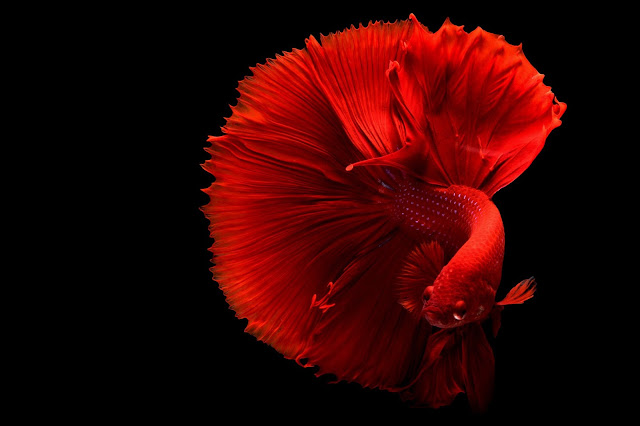Do you feel BETTAs are small, fragile
and very sensitive to handle?
I don’t think so. When it comes to BETTA, I would say
B - Brawling
E - Endearing
T - Tenacious
A - Abiding
s are really amazing fishes as I abbreviated.
Betta fish are very vibrant and colorful
fishes and are easy peasy fish for beginners. These are the so-called “Siamese
Fighting Fish”. Amongst Bettas, the Male fishes are much more attractive and colorful
when compared to the Females. Male Bettas have considerable long Fins and Tails.
There are quite specific reasons for
which one should buy a BETTA fish. Let me jot down.
- Colorful and attractive
- Very hard fish which can easily adapt to your tap water.
- It needs no aeration as it comes to the surface to breathe.
- It requires a very small setup.
- Good breeder
Let me give some tips on how we can
maintain the BETTA fish happy and healthy. So that it can live longer than you
expect.
1. Appropriate aquarium setup
A clutter-free environment is
essential, even in a betta fish tank. This paves way for the fish to be healthy
and happy.
The species tends to live a
minimalist life. They are fond of their space and freedom, so avoid crowding
the tank by using a lot of plants, figurines, or mini castles. Keeping it undecorated
would be very good.
When it comes to space, 3 gallons
would be required for a single BETTA fish.
Also, let me discuss the factors to
take into consideration for a proper aquarium.
§ Glass or acrylic tanks would be apt.
§ The gravel having water-absorbing properties would be good.
§ Blood worms & Dried Tubifex worms would be it's favorite.
§ Fish and water treatments.
2. Tank maintenance
The betta fish likes stagnant water and hence a simple filter which doesn’t make much waves would be preferable.
The next point is the optimal temperature
between 75 and 82 degrees Fahrenheit would be very good. It should not be too
cold or too hot.
As for the pH levels are concerned, anywhere
between 6.8 and 7 would be better. It is better not to use tablets or additives
to maintain the aquarium’s pH levels. Also, there are pH test kits for you to
check the water once every week.
An important note that I would like to
mention is that before placing items such as gravel, plastic plants, etc. in
the tank; don’t forget to check whether these have any sharp edges. When left
unnoticed it might slit your BETTAs fins/tails. Hurts your pet and your heart, be
careful.
3. Betta health check

The next step is to take care of you Betta.
Note down the below checklist so that you can easily follow up.
§ Scales – they need to be smooth.
§ Colour – it should be clear and bright.
§ Quick movements – happy, healthy fish are fond of showing off.
§ Fins – without any slits or fungal infection.
Increasing the lifespan of a betta
fish in captivity is not difficult if you keep a close eye on them. With
bubbles forming on the water’s surface you can rest assured that your pet is
happy and healthy.
4. Diet
These types of fish have a normal appetite. When you feed them
nutritious frozen or fresh foods, they tend to grow fast. But that doesn’t mean
that betta fish don’t enjoy tasty treats. These include small crustaceans,
insects, and worms.
If you spot symptoms of constipation
or body swelling, it means you need to stop feeding the fish for a few days.
And when you start feeding again, provide just live food. This particular
practice contributes to improving the condition of the fish.
Once your betta gets better, reduce
the quantity of food to prevent all symptoms of constipation.
Let me tell you more about feeding
betta fish. For them, small meals work just fine. But if that doesn’t fit your
schedule, then feed the fish twice a day. But make sure that you provide enough
food each time.
After feeding, eliminate the uneaten
remnants from the aquarium. Otherwise, they might affect the health of the
betta fish in the long run.
5. Look for unusual signs
Typically, betta fish likes to swim
near the surface of every tank. At such times, if you find one floating, it
means danger.
No matter how hard you try, dealing
with an occasional sick or injured fish is inevitable. So, I’ve listed a few
unusual behaviors of a sick fish.
§ Clamped fins.
§ Swimming in a bizarre pattern.
§ Reaching the top for air constantly.
§ Hiding a tad too much.
§ Scratching the body against tank accessories.
§ Trembling or shaking.
These symptoms are also associated with cotton wool disease, velvet, or ich. All the conditions require you to use over-the-counter medication that contains malachite green. You can add this along with aquarium salt to the betta fish tank.
If you are willing to keep your Betta fish in a communal tank, then please do read this article to know more about the communal fishes https://tropicalpets.blogspot.com/2019/02/fishes-for-beginners.html
So, I feel I would have clarified your doubts by now. And its time for you to get into action. Keep in mind the tips that I have shared.
Do
you have any other valuable tips to add? If
you come across any interesting stories of your Betta fish, please do leave a
comment. Your comments and feedbacks are very much appreciated!
Until then….






Comments
Post a Comment